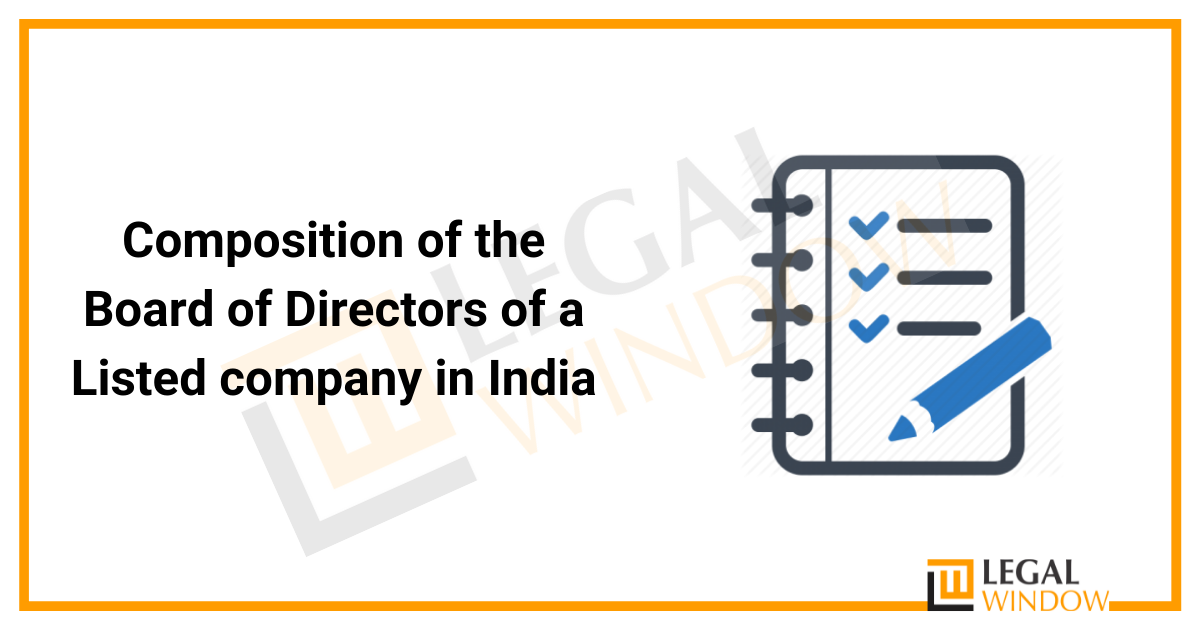Composition of the Board of Directors of a Listed company in India
- April 26, 2022
- Compliance

A board of directors is a panel of people elected to represent shareholders. The board is in charge of protecting shareholders’ interests, establishing policies for management, oversight of the corporation or organization, and making important decisions on issues a company or organization faces. This blog talks about the ‘Composition of the Board of Directors of a Listed company in India’.
| Table of Content |
Board of Directors and its Composition
The board of directors can be knowns as the brain of the company as they are responsible for taking all the big decisions and making policy changes for the company. The decisions are taken in the special meetings members of the board held together, which meeting is known as ‘Board Meetings’.
Section 149(1) of the Companies Act,2013 talks about the minimum and maximum number of directors in a company. The following points are in the section:
- The minimum number of directors in a Private Limited Company is 2;
- For the Public Company it is 3 directors; and,
- An OPC shall have a minimum of 1 director.
However, the maximum number of directors a company have is 15. The no of directors can raise the number of directors beyond 15. And the change in the number of the director is by passing a special resolution in the general meeting.
Other Requirements for Composition
- The maximum number of companies that an individual can become a director of, is 20 companies.
- At least one director, who has lived in India for a minimum of 182 calendar days of the previous year, shall be appointed by every company’s board. It is a mandatory rule.
- At least, a one-woman director must be there in the company.
- All listed companies must have at least one-third proportion of their board of directors as independent directors.
Structure of Board of Directors
Board of Directors members have different places within the panel. The composition of the board varies on the companies and state laws.
The size of the directors has certain limits as per a company as the minimum and maximum limit in its Articles of Association. Companies commonly have 3 to 31 directors. Following are some designations and positions common to a Board of Directors in public companies:
- Chairman of the Company: A chairman of a company leads the board and thus heads the committee or board meetings. The chairperson is elected by the votes of the Board of Directors. Generally, the company’s chief executive officer is the chairman.
- Executive Director of the Company: Executive director is an individual who takes active participation in the company’s administration, business procedures, sales, and finances. An executive director is a part of the board and also gets a salary for the company.
- Non-Executive Director of the Company: A non-executive director doesn’t belong to the organization but is a part of the board. Such directors provide critical opinions and advice by charging a certain fee. In addition, they give voice to stakeholders outside a firm.
- Managing Director of the Company: There are no restrictions on the number of directors in a company by law. A managing director is an individual whose selection is by the company’s executive directors for managing, guiding, and monitoring business functioning.
Other designations in the company are: Vice Presidents, CFOs, treasurer, zonal head, vigilance chief, audit chief, etc., are some other designations common to a BOD.
Composition of Board of Directors in a Listed Company
According to Regulation 17 of Securities and Exchange of India (Listing Obligations and Disclosure Requirement) 2015, the following are the composition of the Board of Directors in a listed company:
- Board of directors shall have a mixture of executive and non-executive directors with at least one-woman director and not less than 50% of the board of directors shall constitute non-executive directors.
- If the chairperson of the board of directors is a non-executive director, then at least one-third of the board of directors shall constitute independent directors and if the listed entity has an executive chairperson, then at least half of the board of directors shall comprise of independent directors.
 Conclusion
Conclusion
Therefore, it is clear from the above that the board of directors can have 3 to 30 members. Section 149(1) of the Companies Act, 2013 talks about the minimum and the maximum number of directors in a company.
If you want to get to know more about this contact us and get advice from legal experts.
CS Urvashi Jain is an associate member of the Institute of Company Secretaries of India. Her expertise, inter-alia, is in regulatory approvals, licenses, registrations for any organization set up in India. She posse’s good exposure to compliance management system, legal due diligence, drafting and vetting of various legal agreements. She has good command in drafting manuals, blogs, guides, interpretations and providing opinions on the different core areas of companies act, intellectual properties and taxation.
Categories
- Agreement Drafting (23)
- Annual Compliance (11)
- Change in Business (36)
- Company Law (148)
- Compliance (90)
- Digital Banking (3)
- Drug License (3)
- FEMA (17)
- Finance Company (42)
- Foreign Taxation (6)
- FSSAI License/Registration (14)
- GST (118)
- Hallmark Registration (1)
- Income Tax (200)
- Latest News (34)
- Miscellaneous (164)
- NBFC Registration (8)
- NGO (14)
- SEBI Registration (6)
- Section 8 Company (7)
- Start and manage a business (21)
- Startup/ Registration (128)
- Trademark Registration/IPR (40)
Recent Posts
- Post incorporation compliances for companies in India April 30, 2024
- Startup’s Guide to Employee Stock Ownership Plans April 29, 2024
- Master Secretarial Audit: A Complete Compliance Guide April 27, 2024
About us
LegalWindow.in is a professional technology driven platform of multidisciplined experts like CA/CS/Lawyers spanning with an aim to provide concrete solution to individuals, start-ups and other business organisation by maximising their growth at an affordable cost.








